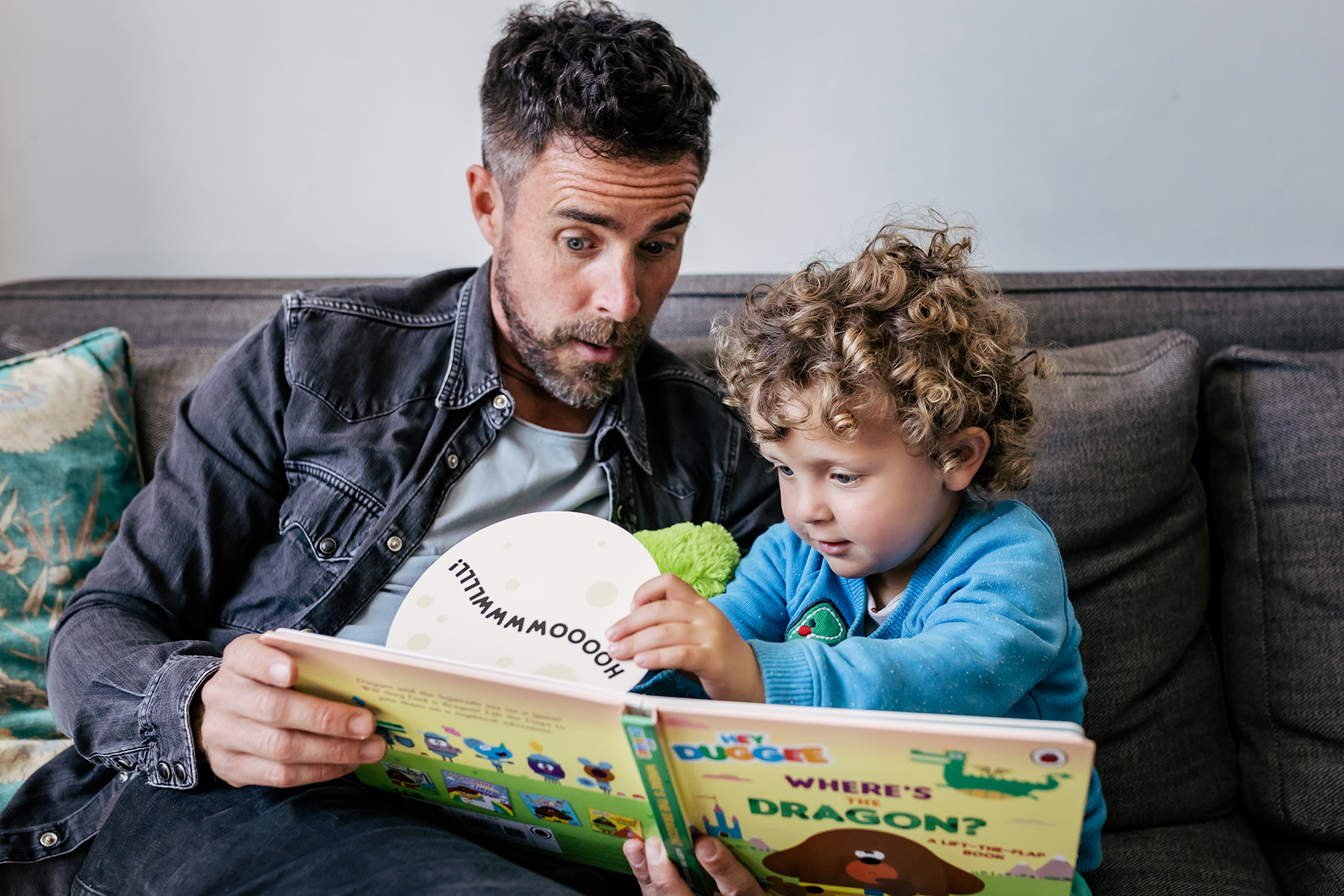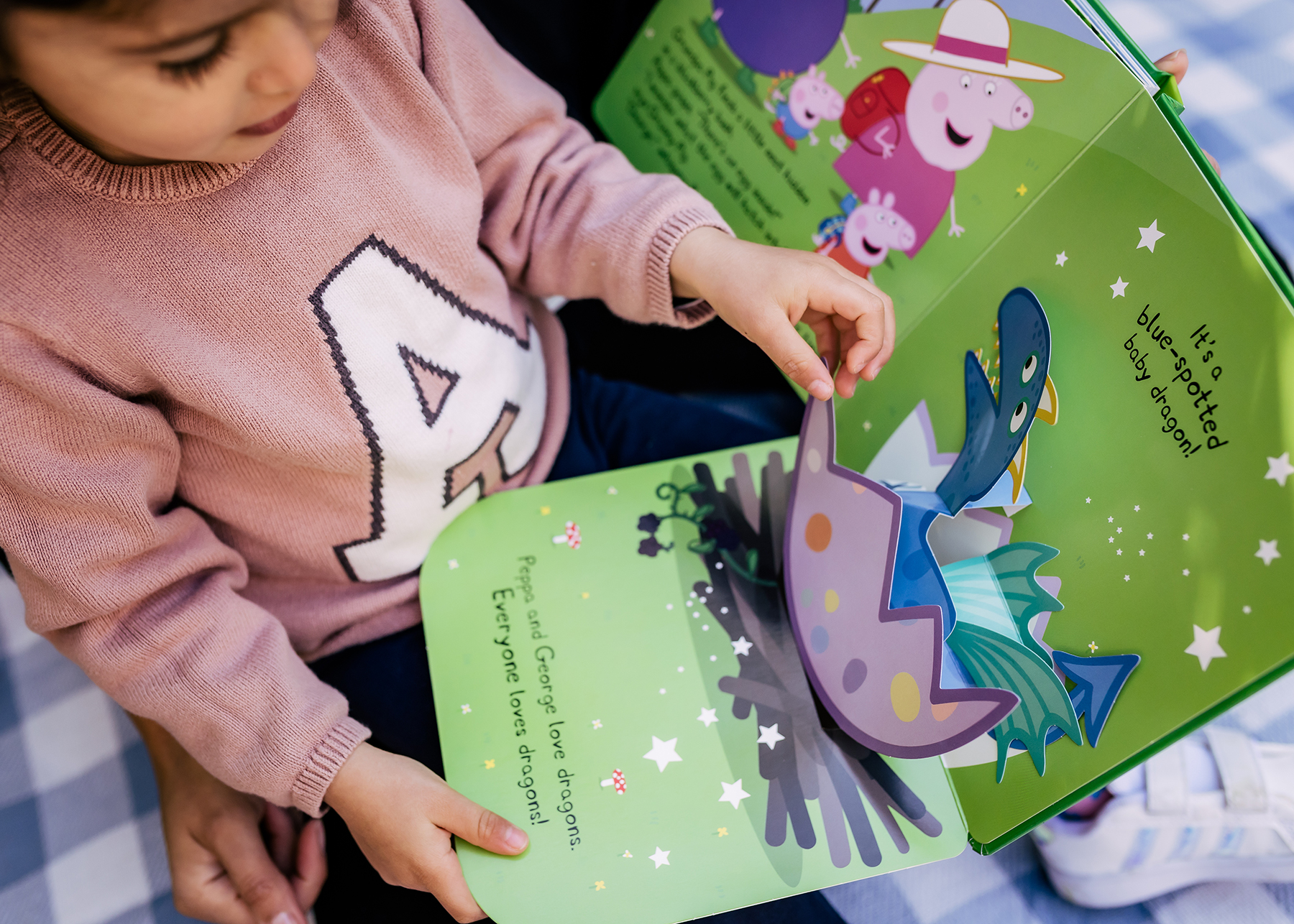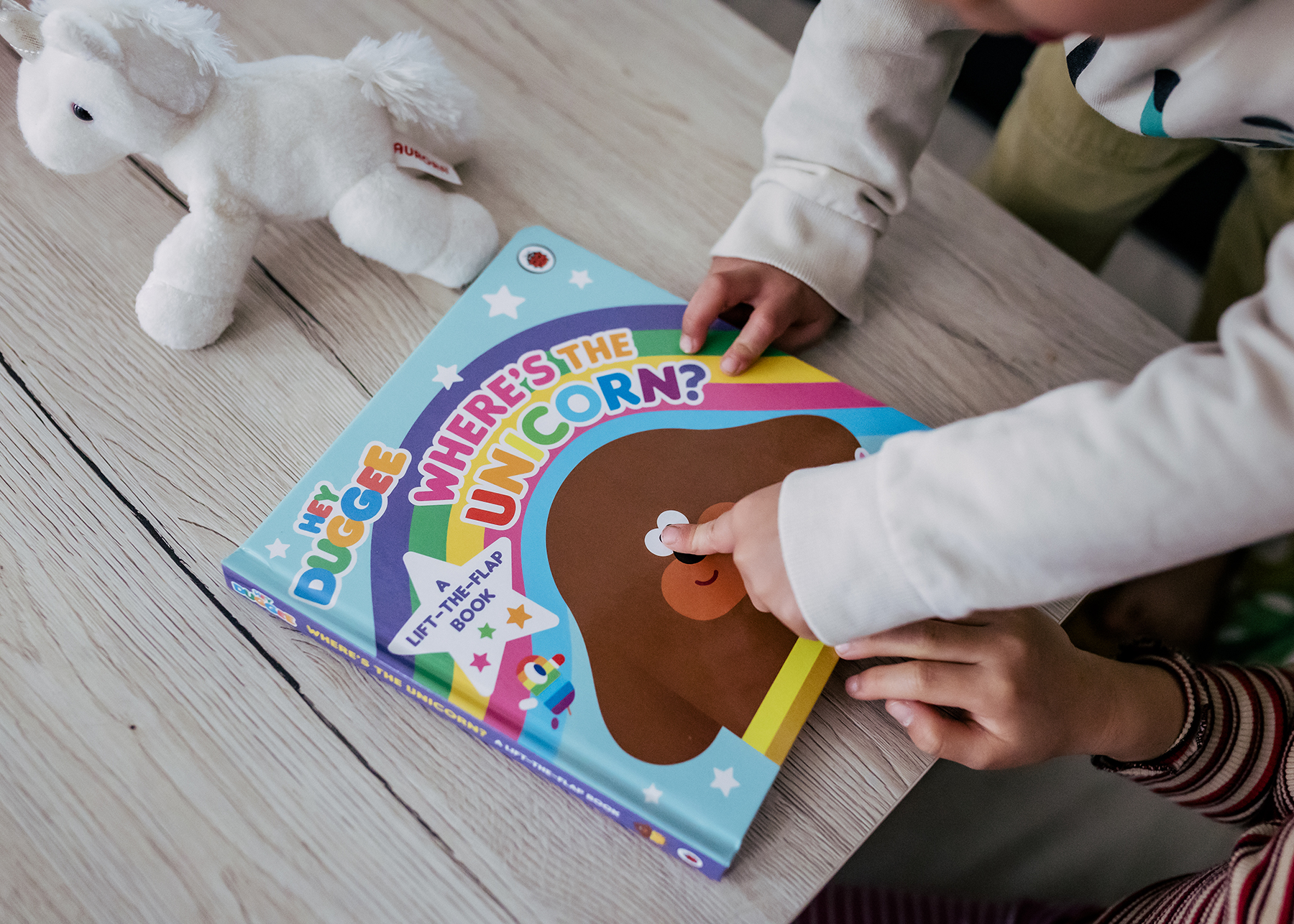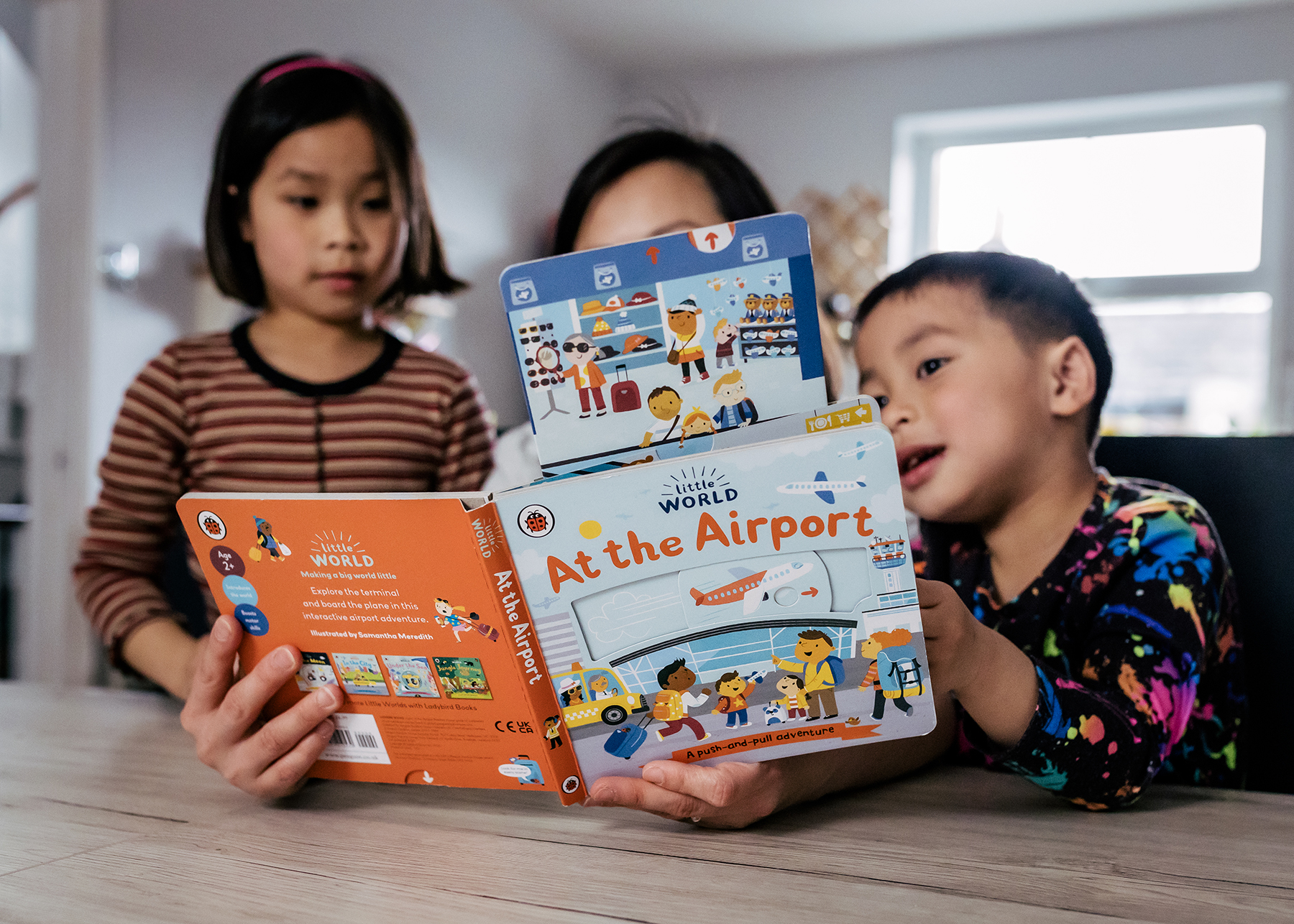- Home |
- Search Results |
- How to help your child learn to read

It’s never too early to start introducing your little ones to the world of books and reading – but what’s the best way to get your child started on their reading adventure? If you’re wondering how best to prepare your pre-schooler for their first steps in reading, or if you want to support your school-age child as they begin to develop their reading skills, then this guide on how to help your child learn to read will offer you a helping hand, as you learn together.
Reading with pre-schoolers
Even before they can talk, babies love sharing books. There’s so much to enjoy, from following the sound of your voice as you tell the story, to looking at bright pictures while helping to turn those big pages. Babies can learn lots of important lessons about language just from hearing you read a story and talk about the pictures. Perhaps the most important thing they learn, though, is to associate books with fun, comfort, and enjoyment. Bathtime, mealtime or bedtime all are made better by stories! They transform daily routines into big adventures full of unforgettable characters, exploration, and play.
That’s one of the reasons why reading with pre-schoolers – and older children too – is so important. The more fun they have sharing books with you, the more likely it is that they will want to learn to read for themselves. And this pleasure in reading and their wish to do it independently is what will keep them going through the sometimes tricky, first stages of learning to read.
As well as reading to your child, you can also do some fun activities together which will help them get ready to read. Don’t forget that all children learn to read at different paces, and there’s no point in trying to make your pre-schooler learn to read before they’re ready. It’ll probably just make you both feel frustrated. Rest assured that if you’ve shared lots of books with them and got them singing some nursery rhymes and action songs along with you, you’ve already given them a great start on their reading journey. But here are a few other things you can try if your pre-schooler is showing signs of being ready to start learning to read.

Fun with words, letters and sounds
Listen up!
One of the key skills children need when they start to learn to read, and as you help them learn to read, is the ability to hear all the different sounds in a word – for instance, knowing that a word like ‘dog’ is made up of three sounds, ‘d’, ‘o’ and ‘g’. A good way to tune in your child’s ears to these sounds is to play some sound and listening games.
• Make a sound: silly or sensible, loud or soft, and get your child to copy it. Then ask them to make a sound for you to copy too.
• Play with the sounds around you. When you’re out on a walk, keep your ears open and see how many different sounds you can hear: cars, footsteps, birdsong, the wind in the trees, and so on. Give your child a point for each sound they hear - and an extra point if they can copy it!
• Have fun with animal noises. Can your child make the right noise when you say an animal name (cow, duck, elephant . . .)? Why not add some funny actions too!
Rhyme time
If your child can hear and copy rhymes, they’ll have a real head start with reading.
• Say a simple one-syllable word, like ‘pat’, and ask your child to say a word that rhymes with it. It doesn’t matter if this is a real word (like ‘bat’) or a made-up one (like ‘dat’) – the important thing is that they’ve heard and copied the rhyme.
• Say your child’s name (or a favourite toy’s name, or a friend’s name) and see how many rhyming words your child can think of.
• Sing or say some rhyming songs, nursery rhymes or poems together. Pause at the end of a rhyming line and let your child add the rhyming word (‘Twinkle, twinkle little star, How I wonder what you...’).
Acting like a reader
When they share a book with you, your child will be learning some of the skills they’ll need when they start reading.
• Point to the words as you read. This helps your child to spot that words are made up of groups of letters and that words go from left to right and from top to bottom on the page. As they get more experienced, you could ask them to have a go at pointing under the words as you read. Praise them when they keep their pointing finger under the words and move it along from left to right!
• Use words like ‘cover’, ‘page’, ‘picture’, and ‘words’ when you talk about books, and praise your child for using those words appropriately too.
• Let your child find the first page of the story before you start reading, and encourage them to turn the pages as you read.
• When your child is choosing a book to read, help them by reading the back cover and talking about the story and the cover pictures together.
• Talk about books as you read – tell your child what you think about the story (or the information in a non-fiction book) and encourage them to tell you their ideas too. You could say, ‘I wonder what’s going to happen next? to spark a conversation with your tot.
• Encourage your child to talk about their own experiences when you are reading together. For instance, ‘That reminds me of when we had a picnic with Grandma,’ or ‘I don’t like tomatoes either!’

Know your ABCs
Many pre-schoolers enjoy learning the names of all the letters of the alphabet, and there are lots of fun ways to do this.
• Choose an alphabet book with appealing pictures and look at it together. Can you and your child think of more words that start with each letter?
• You could make your own alphabet scrapbook with pictures and words for each letter.
• Sing an alphabet song together.
• When you’re reading to your child, sometimes ask them to tell you which letter a word begins with. (Don’t do too much of this in one go, or it might slow the story down and spoil the enjoyment!)
Letter sounds
Once your child knows the alphabet, you could introduce the main letter sounds. Explain that although the letter A’s name sounds like ‘ay’, the sound it makes is usually a short ‘a’ sound, like at the start of ‘apple’. Look at an alphabet book, frieze, or flashcards together and help your child to make the most common sound for each letter.
Use the short vowel sounds (‘a’ as in ‘apple’, ‘e’ as in ‘egg’, ‘i’ as in ‘igloo’, ‘o’ as in ‘octopus’, ‘u’ as in ‘umbrella’). They’ll learn the long vowel sounds later, along with all the other sounds letters can make!
For the consonants, like ‘s’, ‘t’, ‘b’ etc., try to say the sounds without adding an ‘uh’ sound at the end. So the ‘s’ sound is ‘ssss’ like a snake hissing, not ‘suh’, and ‘t’ is a crisp ‘t’ sound rather than ‘tuh’.
Really reading
Once your child knows their alphabet and some of the letter sounds, they could try reading some real words if they like!
• Pause when you’re reading a familiar story and let them read the next word. Encourage them to say the letter sounds and blend them together to read the word (e.g. ‘Bo-Peep up the hill I spy Jack and... J-i-ll, Jill!’).
• Play ‘hunt the letter’ or ‘hunt the word’. Say ‘Can you find the word ‘cat’ on this page?’ Or ‘Can you find a word that starts with ‘m’?’
• You could buy or make some flashcards with simple ‘CVC’ (consonant-vowel-consonant) words like ‘hat’, ‘bed’, ‘tip’, ‘dot’, ‘cup’. Ask your child to say the sound each letter makes and then put all the sounds together to read the word, e.g. ‘c-u-p, cup’.
• Encourage your child to look for words and letters in the world around them – on posters, road signs, shop signs, etc. Give them lots of praise for recognising and sounding out some of the letters and words.
• Don’t be tempted to push your pre-schooler to do more reading than they want to. A few minutes of reading or word games at a time is plenty! It’s much better that they enjoy their early experiences of reading – if they overdo it, they may end up feeling tired, bored and frustrated, and less keen to read in the future.
Helping your school-age child with reading
Whether they already knew their alphabet and letter sounds when they started school, or whether they just started learning in their first year in primary school, there is plenty you can do to support and encourage as you help your child learn to read. Lots of the games and activities suggested in this article under ‘Fun with words, letters and sounds’ above are still very appropriate for school-age children who are beginning readers. And as they practice their reading skills at school, there are lots of new ways you can help them.
It’s useful to know a little bit about the methods your child’s school uses to teach reading. If your child’s teacher hasn’t already invited you to a parents’ evening or meeting about it or sent home an information leaflet, it’s worth making an appointment with them to chat about what your child is learning at school, and how you can help. The information below gives a quick overview of how most schools in the U.K. currently teach early reading.
How schools teach reading
Reading isn’t really just one skill - it’s a whole collection of skills, which is why it usually takes children some years to become truly independent readers. Every child learns to read at a different pace, and it’s very important not to worry if your child seems to be ‘behind’ others in their class. Some children pick up the initial skills of reading very quickly, but then seem to run out of steam; others may take a while to show much progress, but then race ahead. And of course, lots of children just pick up the skills gradually and make slow and steady progress at their own pace. But one way and another, almost every child learns to read independently by the time they go up to secondary school – especially if they get lots of support at home!
Broadly speaking, we can divide the teaching of reading into two main parts – word reading, and comprehension. Both word reading and comprehension are taught at the same time – children don’t have to know how to read words before they can start to understand stories, and they don’t need to understand stories before they can start learning to read the words.
Word reading - phonics
Nowadays, most UK primary schools use phonics as their main approach to teaching word reading. This means that your child’s teacher will be teaching them about letters and sounds in a specific order, gradually building up the letter patterns and sounds that your child knows so that they can read increasingly complex words.
Most schools start formally teaching phonics at the start of their first year of school. They begin by introducing a small group of letters – usually ‘s’, ‘a’, ‘t’, ‘p’, ‘i’ and ‘n’. Children are taught one sound for each of those letters (with the short vowel sound ‘a’ as in ‘apple’, and the short vowel sound ‘i’ as in ‘igloo’). They learn to read words by sounding out the letters, and then blending the sounds together to read the word (e.g. ‘s-a-t, sat’). Using these letters and their sounds, children can quickly read simple words like ‘sat’, ‘pin’, ‘tap’, ‘pit’ and ‘sip’. They can even read a few short ‘nonsense’ sentences, such as ‘Pat is in a pit’.
The letters and sounds are taught very quickly and practised over and over again until they are very familiar. Then more letters and sounds are added so that soon children know all the letters of the alphabet and one simple sound for each letter.
Once children know all these letters and sounds, they can begin to learn more complex sounds and letter patterns.
Learn with Peppa Pig
Phonemes and graphemes
‘Phoneme’ and ‘grapheme’ are phonics terms that your child might learn at school and talk about at home. Graphemes are letters or groups of letters, and phonemes are the sounds they make.
Some graphemes are simply one letter – so the grapheme ‘t’ makes the phoneme ‘t’, and the grapheme ‘a’ makes the short vowel phoneme ‘a’ as in ‘apple’. Some graphemes and phonemes are a lot more complex – for instance, in the word ‘night’, the long ‘i’ phoneme is made by a three-letter grapheme, ‘igh’. So although there are five letters in ‘night’, there are only three graphemes – ‘n-igh-t’.
Children learn to sound out each grapheme in turn to read the word – e.g. ‘r-ai-n, rain’, or ‘h-a-pp-y, happy’.
Children also learn that there are lots of different graphemes that can make the same phoneme – e.g. the long ‘i’ phoneme can look like ‘igh’ in ‘night’, ‘y’ in ‘fly’, ‘i-e’ in ‘bike’, ‘ie’ in ‘pie’, ‘i’ in ‘mind’ … and so on!
They will also learn that the same grapheme can often represent different phonemes – for instance, ‘ou’ sounds different in the words ‘out’, ‘young’, ‘pour’, ‘route’, etc.
Word reading – tricky words
You don’t have to know much about the English language to realise that not every word follows the phonic code! There are lots of very common words that can’t be sounded out using basic phonics – including many of the most useful words in English, such as ‘the’, ‘was’, ‘one’, ‘were’, ‘their’, etc. These words just have to be learnt by sight. Fortunately, because they’re so familiar, children get lots of practice with them!
Comprehension
Right from the very start of school, your child’s teacher will be helping them to develop their comprehension skills.
To begin with, the books and other materials that children read for themselves in school tend to be very simple. Because they are designed to practise only (or mostly) the phonics your child is learning, sometimes these early phonic reading books don’t tell much of a story! The very earliest reading books are mostly about practising word reading. But even in these books, there is usually a simple story or some information, which may be partly conveyed by the pictures. Children are encouraged to talk about what they read and share their ideas about it.
Alongside their early phonic reading books, your child will also be enjoying a range of longer and more complex stories and information books, which the teacher will share with the class or group. These richer and more complex books give your child lots of opportunities to think about the story or information and share their ideas with other people. Your child will be developing their comprehension skills by:
• Making predictions about what the book will be about, or what will happen next in the story.
• Making connections between the book and their own experiences.
• Thinking about how characters in the book might feel.
• Enjoying the sounds and meanings of new words, and perhaps using these words in their own speech or writing.
• Expressing their own views about why a character might behave the way they do.
• Giving their opinions about the story or information in the book – did they enjoy it, and if so, what did they like best?
How to help your child with phonics, tricky words and comprehension
Your child’s teacher will probably send your child home with reading books at the right level for them. Usually, these books will practise the phonics your child is currently learning in class – and they may also include some of the tricky words your child needs to know how to read.
You can support your child by listening to them read, helping them when they get stuck, and talking with them about what they have read.
Helping when your child gets stuck on a word
If your child gets stuck on a particular word as they are reading, always encourage them to use the phonics they know to help them work the word out. Ask them to sound out each phoneme (sound) in the word and then blend the phonemes together to read the word – e.g. ‘t-r-ai-n, train’. If they are still stuck, or if the word contains sounds that they don’t know yet, show them how to sound it out and blend it, and ask them to copy you.
Don’t worry if there are several words your child can’t read at first sight – the important thing is to keep practising! If your child is really stuck on a word, it’s fine just to read it for them and move on quickly. Try not to get upset or impatient with them – it’s natural for beginner readers to struggle sometimes because they’re learning to do something difficult! It’s better to give them the words they can’t read than to keep stopping and slow the story down.
If your child gets stuck on a ‘tricky’ word – a very common word like ‘where’ or ‘what’ that can’t be read using phonics alone – you could ask them to think about the meaning of the whole sentence, and use the first few letters of the word to help them work out what word would make the best sense. Again, if they are really stuck, just read the word to them and move on. It might be worth making a list of any tricky common words that they don’t know, so you can practise them later.
Helping with comprehension
Because of the focus on phonics, some children get a bit fixated on reading the words in their book, sounding them out, and blending them, and they can forget to think about the meaning! This means that they might not be following the story, or understanding the information in their book.
This is completely understandable because their little minds are busy trying to use all the phonics they know to work out the words – they don’t have the brain space to think about the meaning too. However, good readers have to be able to think about the meaning as well as just reading the words. And this takes practise!
There are lots of ways you can help your child with comprehension.
• Talk about the book with them, asking their opinion of the story or chatting about the information in the book
• Encourage them to pause in their reading from time to time, look at the pictures and talk about what the characters might be thinking or what might happen next.
• Talk about any ways in which the book links to things your child already knows, or things they have done – e.g. ‘Do you remember, we went on a train like that on holiday!’ or ‘How did you feel when you lost your teddy like the boy in the book?’
• If they enjoyed a story, encourage them to retell it to you – can they remember the main things that happened? Look back at the book to remind them if necessary.
• Keep reading books to them, as well as listening to them read. Right through primary school, children need to hear and share stories that might be too tricky for them to read alone. Listening to you read a longer book to them gives your child the opportunity to think about the story or the information, without having to focus on reading the words. This will really help exercise their comprehension muscles!
Not just school books
As well as the reading books that your child brings home from school, there are lots of other resources you can use to help your child. For instance, the Read it yourself series helps children develop and improve their reading skills, with illustrated stories and non-fiction that gradually increase in challenge as they progress. Each book is carefully written to include many high-frequency words, as well as a limited number of story words that are introduced and practised throughout.
Top tips for reading with school-age children

Pick your time
It sounds obvious, but it’s worth keeping reading sessions for times when your child isn’t too hungry, tired or distracted to focus. Everyone’s different, and you’ll know the times that work best for your child. Straight after school when they want to play, or just before bedtime when they’re low in energy, may not be the best times! Some families like to read in the morning before school, or mid-evening between teatime and bedtime. If you can, it also pays to pick a nice quiet place where your child won’t be distracted by other entertainment (or even noisy siblings!).
Keep it short – and fun!
Learning to read is hard work for most children! It’s often better to have a short, focused ten-minute reading session rather than a long half-hour slog which is just exhausting for everyone. Little and often is good!
Let your child stop reading when they’re tired and have had enough - you can always go back to it later. Keep the atmosphere fun and positive, by chatting about what your child is reading and helping them if they get stuck (see the tips above). Don’t forget to give them lots of praise for their efforts!
Go with your child’s interests
As well as the books they bring home from school, encourage your child to choose some books for themselves. The library is your friend here – and bookshops are also full of lovely books with lots of appeal for children and parents alike. If you let your child choose their own books sometimes, you’ll find they’re that much more motivated to read them – and you can always help them, or read to them if they choose books that are too tricky for them at the moment.
It’s also worth bearing in mind that not everyone loves stories! And children’s interests change as they get older – so variety is the key. We often think of storybooks when we think of early reading, but your child will get just as much fun and essential reading practise by reading comics, age-appropriate websites, non-fiction books on subjects that interest them, leaflets, magazines, the back of the cereal packet... the list is endless!
Be a reading family
Even when your child can read a whole book without needing any help at all, it’s still important to keep reading to them – this way, they get to experience and enjoy longer and more complicated books, and they also get to enjoy some special time with you! There’s nothing to beat the feeling of snuggling down with a book you’re both enjoying, desperate to find out what happens next...
It’s also really helpful if your child can see you reading – whether that’s taking time to enjoy a novel, snatching five minutes with a newspaper or magazine, following a blog or doing some research for a trip or holiday. All of this will help your child see that reading is important to you – and this will help them to value it too, and create a lifelong love of reading.